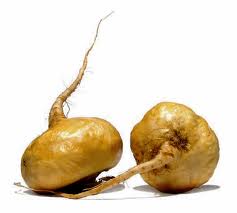 Maca, a herbaceous biennial plant, is native to the high Andes Mountains of Peru and Bolivia. Maca has been harvested by humans for hundreds of years. The growing demand for maca as a supplement has increased in production significantly in the last ten years, with maca flour being the most prominent form consumed today. Used in baking as a flour and flavor agent, maca is not typically eaten raw since it can cause gastric problems unless it is cooked. Another common method for preparing maca is the gelatinized form. In this extrusion process, the tough fiber is extracted from the roots using a gentle amount of heat and pressure. Gelatinized maca is used for therapeutic and supplement purposes, but can also be used like maca flour when cooking.
Maca, a herbaceous biennial plant, is native to the high Andes Mountains of Peru and Bolivia. Maca has been harvested by humans for hundreds of years. The growing demand for maca as a supplement has increased in production significantly in the last ten years, with maca flour being the most prominent form consumed today. Used in baking as a flour and flavor agent, maca is not typically eaten raw since it can cause gastric problems unless it is cooked. Another common method for preparing maca is the gelatinized form. In this extrusion process, the tough fiber is extracted from the roots using a gentle amount of heat and pressure. Gelatinized maca is used for therapeutic and supplement purposes, but can also be used like maca flour when cooking.
Key Nutrients
Maca is a strong source of iron, calcium and potassium. Maca is also a great source of riboflavin, thiamine, vitamin E and vitamin A. With a high degree of flavonoids, maca is also a powerful anti-oxidant.
Health Benefits
Potassium – Potassium is an essential mineral which aids in fluid regulation, protein synthesis and cardiovascular health. High levels of potassium are associated with reduced risk for stroke, improved blood pressure control as well as bone health.
Iron –Iron, found in red blood cells, is an integral part of hemoglobin. Hemoglobin carries oxygen from the lungs to the cells. Iron is an essential component of many enzymes necessary for various chemical reactions in the body.
Calcium – Calcium is an important mineral for bone and teeth growth and maintenance. It is also an important mineral in terms of cardiovascular function.
Vitamin A – Vitamin A, when converted into retinaldehyde, is a vital compound for healthy eyes. Furthermore, vitamin A is believed to fight against cataracts, macular degeneration and glaucoma. Vitamin A strengthens the membranes of the human body such as mucous membranes, respiratory, urinary and intestinal tracts. It is also essential for the lymphocytes, or white blood cells, that fight infection once in the body.
Vitamin E – Research has shown that vitamin E possesses anti-inflammatory effects that can combat arthritis, rheumatism, asthma, and other inflammatory disorders linked to chronic inflammation. Vitamin E also improves the body’s metabolic function.
Vitamin B1 – Thiamine is an important vitamin since it breaks down sugars in the body. Thiamine also helps to support nerve and heart health.
Vitamin B6 – Vitamin B6 helps to keep your immune system in good working order. It aids in the breakdown of fats, carbohydrates and amino acids while helping to maintain the health of lymph nodes. Additionally, vitamin B6 helps to regulate blood glucose levels.
Vitamin B9 – Folate is an important vitamin for liver function.
Vitamin B12 – Vitamin B12, or folic acid, helps to preserve neurological function and DNA synthesis. It also plays a key role in the health of red blood cells. The nervous system relies on vitamin B12 for proper function as well.
Season
Maca can be found in any supermarket or food retail store year round.
Nutrition Information
Per 1 Tablespoon:
Calories (cKal): 30
Protein (grams): 1.61
Total Fat (grams): .07
Carbohydrates (grams): 5.6
Fiber (grams): .48
Buying and Storing
There are no real issues to consider when buying maca. Since it is typically sold as a flour, maca will store in a sealed container for up to one year.
Best Way to Add to Diet
Maca is best added to the diet in its flour form. For this, add maca to your diet by adding a tablespoon or two to your favorite homemade baked good or dessert.
Maca Recipe

 Not Sure What Healthy Foods To Eat?
Not Sure What Healthy Foods To Eat? This week we take a look at one of my favorite healthy foods...the mighty Avocado.
This week we take a look at one of my favorite healthy foods...the mighty Avocado.
No comments yet.